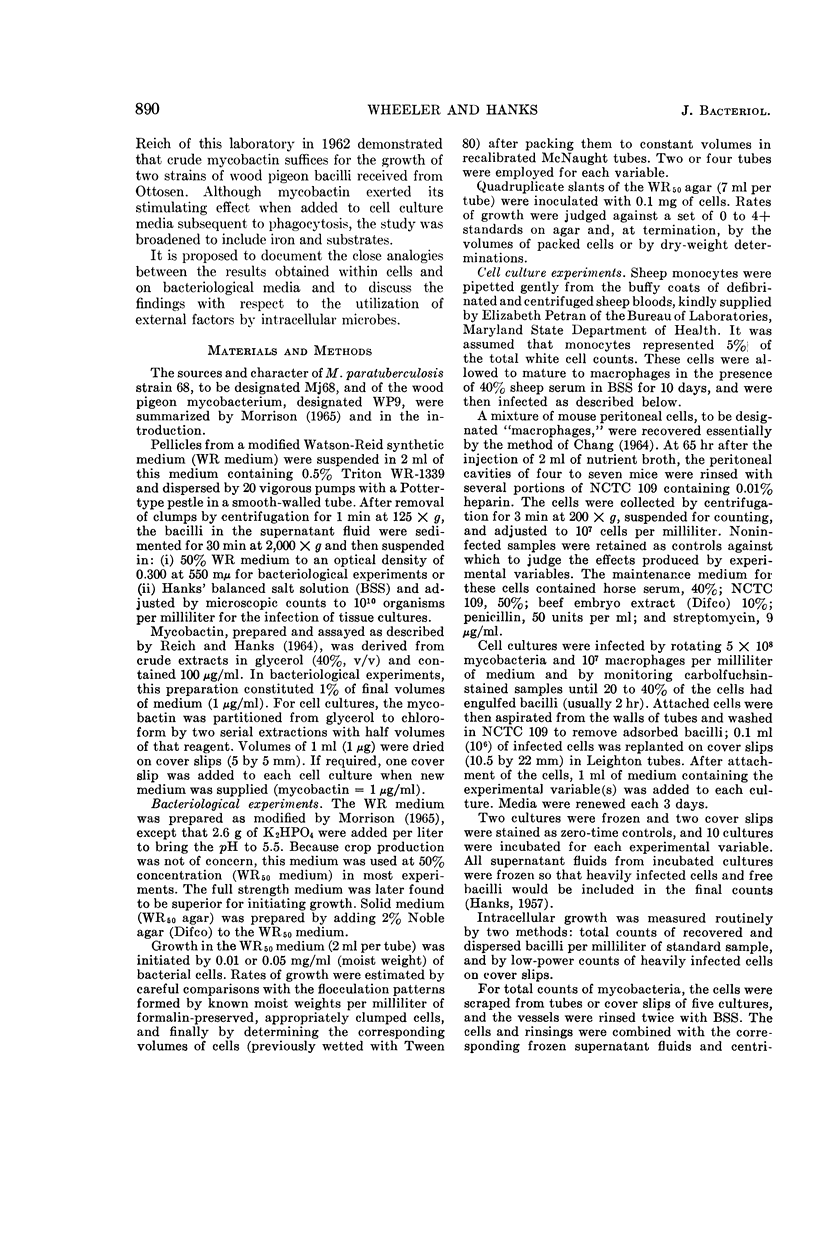Abstract
Wheeler, William C. (Johns Hopkins University-Leonard Wood Memorial Leprosy Research Laboratory, Baltimore, Md.), and John H. Hanks. Utilization of external growth factors by intracellular microbes: Mycobacterium paratuberculosis and wood pigeon mycobacteria. J. Bacteriol. 89:889–896. 1965.—The extent to which the intracellular growth of microbes is dependent upon capacities for growth in vitro has been investigated by use of organisms which require a specific factor, mycobactin, for isolation and growth on conventional mycobacterial media. Similarities between growth on bacteriological media and within tissue cells have been demonstrated by examining the responses of Mycobacterium paratuberculosis and wood pigeon mycobacteria to mycobactin, iron, CO2, and glycerol, and to the low pH which characterizes phagocytic vacuoles. The results indicate that success of intracellular infections depends upon the independent growth of microbes and that the phagocytic vacuoles of sheep and mouse macrophages seem to be freely accessible to bacterial growth factors, minerals, and substrates. Because these factors did not modify the appearance, overall metabolism, or surface properties of macrophages, it was concluded that the intracellular growth of microbes is not determined solely by the components, metabolism, or immunological properties of host cells, but is influenced to an important degree by compounds and conditions provided by extracellular environments.
Full text
PDF







Images in this article
Selected References
These references are in PubMed. This may not be the complete list of references from this article.
- CHANG Y. T. LONG-TERM CULTIVATION OF MOUSE PERITONEAL MACROPHAGES. J Natl Cancer Inst. 1964 Jan;32:19–35. [PubMed] [Google Scholar]
- ELBERG S. S. Cellular immunity. Bacteriol Rev. 1960 Mar;24(1):67–95. doi: 10.1128/br.24.1.67-95.1960. [DOI] [PMC free article] [PubMed] [Google Scholar]
- HANKS J. H. Assay of the fate of Mycobacteria in cell and tissues cultures. Am Rev Tuberc. 1958 May;77(5):789–801. doi: 10.1164/artpd.1958.77.5.789. [DOI] [PubMed] [Google Scholar]
- HANKS J. H., CHATTERJEE B. R., LECHAT M. F. A GUIDE TO THE COUNTING OF MYCOBACTERIA IN CLINICAL AND EXPERIMENTAL MATERIALS. Int J Lepr. 1964 Apr-Jun;32:156–167. [PubMed] [Google Scholar]
- HANKS J. H. Relationship between the metabolic capacity and the infectiousness of M. leprae murium; refrigeration studies. Int J Lepr. 1954 Oct-Dec;22(4):450–460. [PubMed] [Google Scholar]
- HANKS J. H. Retention and differentiation of carbolfuchsin-stained mycobacteria in diagnostic films. Am Rev Tuberc. 1956 Oct;74(4):597–607. doi: 10.1164/artpd.1956.74.4.597. [DOI] [PubMed] [Google Scholar]
- HANKS J. H., WALLACE J. H. Determination of cell viability. Proc Soc Exp Biol Med. 1958 May;98(1):188–192. doi: 10.3181/00379727-98-23985. [DOI] [PubMed] [Google Scholar]
- HIRSCH J. G. Cinemicrophotographic observations on granule lysis in polymorphonuclear leucocytes during phagocytosis. J Exp Med. 1962 Dec 1;116:827–834. doi: 10.1084/jem.116.6.827. [DOI] [PMC free article] [PubMed] [Google Scholar]
- MORRISON N. E. CIRCUMVENTION OF THE MYCOBACTIN REQUIREMENT OF MYCOBACTERIUM PARATUBERCULOSIS. J Bacteriol. 1965 Mar;89:762–767. doi: 10.1128/jb.89.3.762-767.1965. [DOI] [PMC free article] [PubMed] [Google Scholar]
- NEUMAN R. E., TYTELL A. A. Iron replacement of lactalysate and embryo extract in growth of cell cultures. Proc Soc Exp Biol Med. 1961 Aug-Sep;107:876–880. doi: 10.3181/00379727-107-26782. [DOI] [PubMed] [Google Scholar]
- REES R. J., GARBUTT E. W. Studies on Mycobacterium lepraemurium in tissue culture. I. Multiplication and growth characteristics in cultures of rat fibroblasts. Br J Exp Pathol. 1962;43:221–235. [PMC free article] [PubMed] [Google Scholar]
- REICH C. V., HANKS J. H. USE OF ARTHROBACTER TERREGENS FOR BIOASSAY OF MYCOBACTIN. J Bacteriol. 1964 Jun;87:1317–1320. doi: 10.1128/jb.87.6.1317-1320.1964. [DOI] [PMC free article] [PubMed] [Google Scholar]
- WELSCH M. Formation de protoplastes d'Escherichia coli sous l'influence de la glycine et d'autres acides aminés. Schweiz Z Pathol Bakteriol. 1958;21(3):741–768. [PubMed] [Google Scholar]




